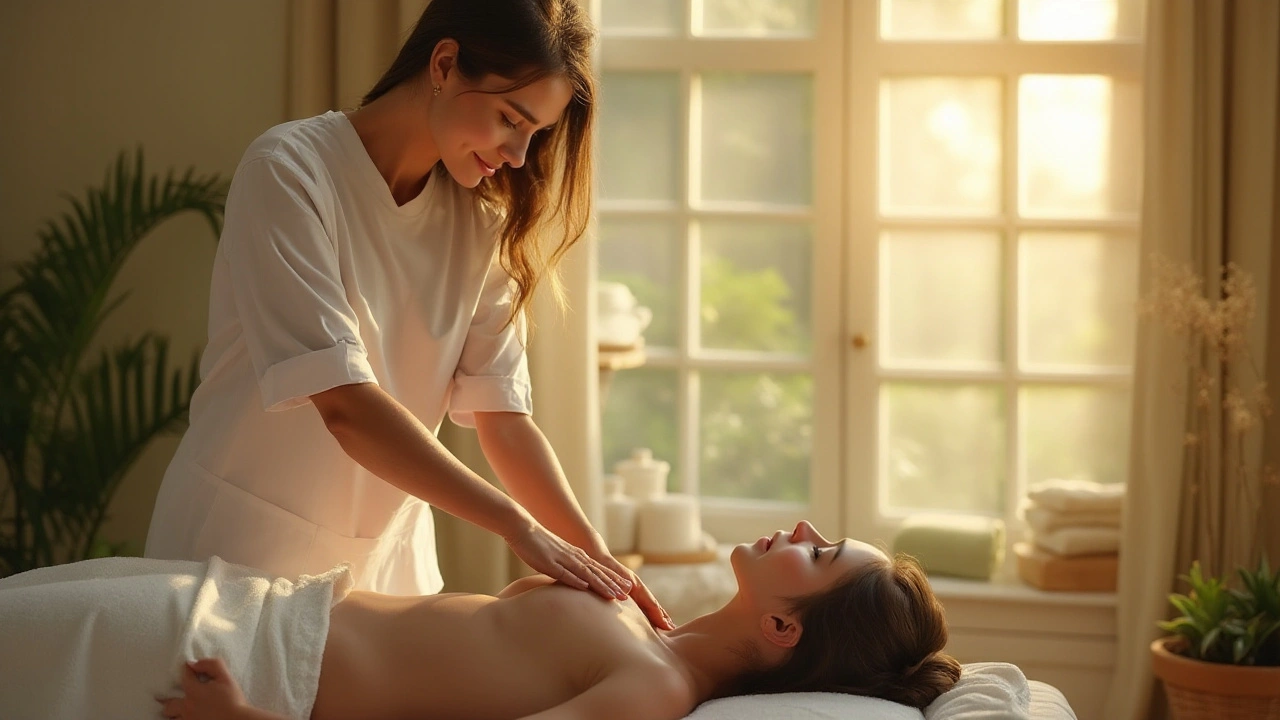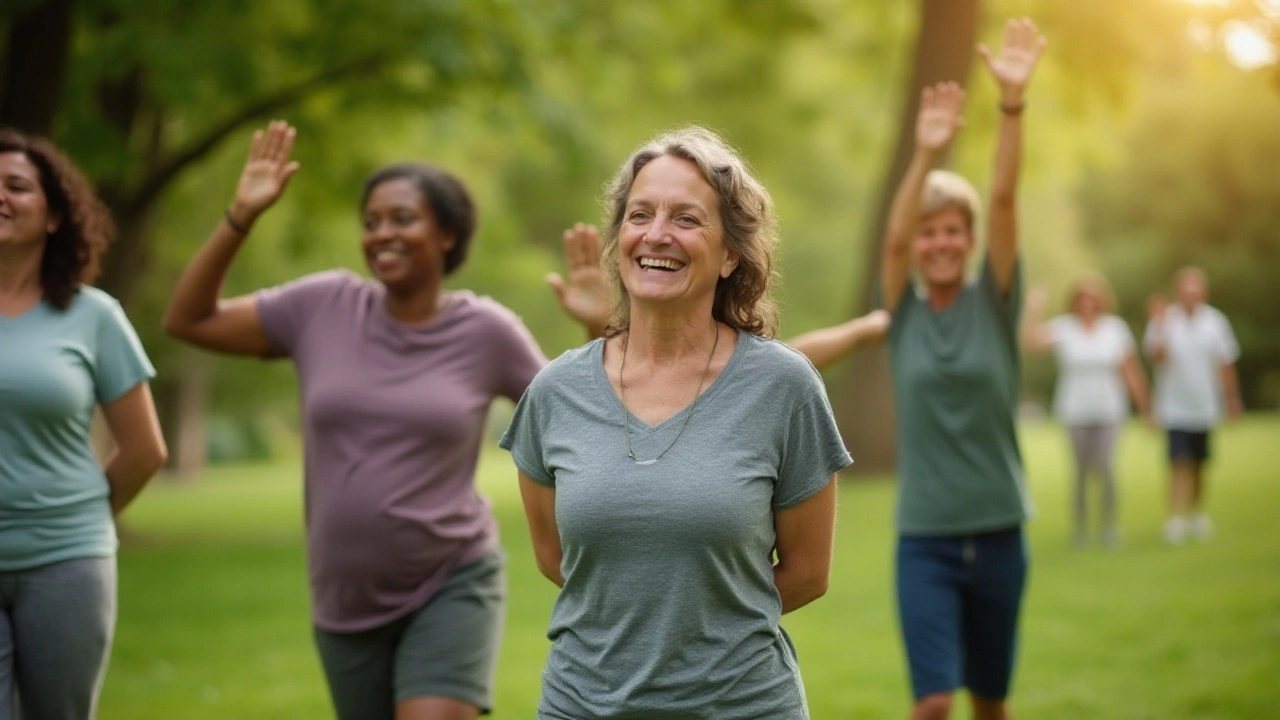Exploring Rolfing: Benefits of This Bodywork Technique
 Nov, 10 2024
Nov, 10 2024
Rolfing, a form of deep tissue bodywork, is often misunderstood but holds unmistakable promise for those seeking physical and emotional alignment. Not only does it address structural imbalances, but it also explores the interconnectedness of body and mind. This therapeutic approach aims to enhance posture, ease chronic pain, and promote overall wellness.
In a world teeming with quick fixes, Rolfing offers a slower, deliberate path to self-discovery and healing. While it may seem intense at first, many find the benefits far outweigh the discomfort. Professionals in this field known as Rolfers work to release tension in connective tissues, gradually allowing the body to realign itself with gravity.
Whether you're dealing with nagging aches or merely curious about alternative therapies, Rolfing might be the journey worth embarking upon. The choice of a qualified practitioner is crucial, but once found, the path unravels with each session, offering insights not just into the patterns of your physical body, but the rhythms of your life.
- Understanding Rolfing: What It Is
- History and Origins of Rolfing
- Benefits of Rolfing for Body and Mind
- What to Expect During a Rolfing Session
- Tips for Finding a Qualified Rolfer
Understanding Rolfing: What It Is
When someone mentions Rolfing, it might conjure up images of intricate body arrangements or perhaps a secret ritual from an ancient time. In truth, Rolfing is a form of hands-on therapy developed by biochemist Dr. Ida P. Rolf. This technique involves deep manipulation of soft tissue, aiming to improve the body's alignment and function. Dr. Rolf's primary objective wasn't just to relieve pain temporarily but to work towards a more lasting structural integration with gravity.
Rolfing focuses not only on muscles but also on the fascial network, the connective tissue that encases and connects all muscles and organs. This network often tightens due to physical stress, injuries, or bad postures, affecting our mobility and well-being. By targeting fascial layers, Rolfing seeks to loosen the tight spots, thereby promoting flexibility, enhancing balance, and integrating the body's structure into a more aligned whole.
Many equate Rolfing with intense massages, yet it stands distinct. While massages often aim to relax, Rolfing is more concerned with the holistic transformation of body mechanics. The practitioner, known as a Rolfer, applies pressure and skillfully encourages the body to release tension, allowing it to realign itself naturally. This can lead to improved posture, decreased pain, and a heightened sense of physical competence.
One fascinating aspect of Rolfing is that it is typically structured over a series of ten sessions, each with specific goals. The sequence is designed to systematically address different body parts or systems, ensuring comprehensive alignment and release. Importantly, sessions are tailored to individual needs, considering the unique history of each body. Hence, the approach is personalized, evolving with each session.
Rolfing isn't solely about the physical. It also embraces the mind-body connection. Dr. Rolf believed that emotional experiences are stored in our bodies, and releasing physical tension might also initiate emotional releases. Some people report improved emotional states post-session, an added benefit beyond the tangible. As the body regains freedom, so too can the mind find new openness.
While Rolfing might seem intensive, those who practice it advocate for its transformative potential. According to the Rolf Institute, "Rolfing opens up possibilities for personal change, allowing people to access states of ease and power they never knew existed." For those curious or seeking new pathways to health, Rolfing offers a unique journey into understanding one's own body in conjunction with the forces of gravity.
Isn't it interesting how something as seemingly innocuous as bodywork can hold such impactful benefits? The process might sound daunting, but for many, the rewards are life-changing. As you ponder this journey, remember that gliding through life with ease isn't just about moving; it's about moving with a harmonious internal structure.
History and Origins of Rolfing
The story of Rolfing begins with Dr. Ida P. Rolf, a pioneering biochemist who developed this innovative bodywork approach in the mid-20th century. Born in New York City in 1896, Rolf pursued a career in science, earning her Ph.D. in biochemistry from the College of Physicians and Surgeons at Columbia University in 1920. Her scientific background laid the foundation for her unorthodox approach to physical therapy. Driven by a desire to relieve her own chronic physical challenges, as well as those of others, she embarked on a journey to explore the body's capacity for healing and alignment.
In the 1940s, Rolf combined her scientific knowledge with her study of alternative therapies, including osteopathy, yoga, and chiropractic work. These diverse influences coalesced into her technique, originally named "Structural Integration". By exploring how gravity impacts the human structure, Rolf hypothesized that many issues people faced were due to misalignments within the body's connective tissues, or fascia. Her work aimed to reorganize this tissue through manipulation, hence alleviating pain and improving posture. This concept of aligning the body with gravity is at the heart of what we now know as Rolfing.
Ida Rolf's efforts reached the public domain by the late 1960s when she began formally teaching her methods. Her work gained traction when she collaborated with Esalen Institute in California, a center known for exploring and fostering personal growth and human potential. It was here that her innovative ideas took root and grew into a comprehensive approach to bodywork that people from various walks of life began to appreciate. The rise of Rolfing in the 1970s correlated with a broader societal interest in alternative health practices, aligning perfectly with the ethos of mind-body wellness.
As her approach gained popularity, the term "Rolfing" was coined by those who practiced and taught her method. This period marked the formal establishment of the Rolf Institute of Structural Integration in 1971. With her institute, Ida Rolf laid the groundwork for a body of professional practitioners who continue to advance her methodology today. The Institute, now known as the Dr. Ida Rolf Institute, remains a center for training and research for those interested in becoming certified Rolfers.
The Legacy of Ida Rolf
The legacy of Ida P. Rolf extends beyond her technique as she challenged the medical community's understanding of structural issues. Her belief that emotional and psychological well-being are interlocked with physical health was pioneering for her time. While initially, her ideas faced skepticism, Rolfing found legitimacy through the visible transformations observed in clients and the growing body of anecdotal evidence supporting its benefits. Today, thousands of practitioners carry forward her mission, believing in and witnessing the profound effects of aligning the body and enhancing its structure to heal deeper issues.
"When the body gets working appropriately, the force of gravity can flow through. Then, spontaneously, the body heals itself." - Ida P. Rolf
This quote encapsulates Dr. Rolf's vision that beneath the surface of physical manipulation lies the potential for organic healing and well-being. Her history continues to inspire new generations seeking holistic approaches to health, reaffirming Rolfing's unique place in alternative bodywork therapies.

Benefits of Rolfing for Body and Mind
Stepping into the realm of Rolfing opens a doorway to profound physical and mental transformation. Those who embark on this journey often report a noticeable improvement in posture, which stands as one of the primary benefits of this unique bodywork therapy. By methodically manipulating the body's connective tissue, known as fascia, Rolfers aim to bring the body into proper alignment with gravity. This enhanced alignment often leads to relief from chronic pain, a common motivation for individuals seeking Rolfing therapy. As the body is adjusted, it learns to move more efficiently, potentially reducing wear and tear on joints and muscles. Such changes can translate to increased physical stamina and overall comfort, making daily activities far more enjoyable and less taxing.
The mental aspects of Rolfing are equally compelling. Many clients find that as their physical tension dissipates, so does mental stress. The connections between our physical state and emotional well-being are rich and complex, and Rolfing offers a unique avenue to explore these. The process encourages a higher degree of body awareness, often sparking insights into habitual patterns of movement and posture that are intertwined with emotional history. This newfound consciousness can serve as a catalyst for personal growth and emotional healing, offering individuals not only physical relief but also a sense of empowerment and self-discovery.
According to Dr. Richard C. Brown, a leading voice in complementary medicine, "Rolfing is not just about fixing the body but understanding the intricate relationship between posture and well-being."
A fascinating element of Rolfing is its ability to enhance mobility. By releasing deep-seated tension and fascial restrictions, the body often gains a greater range of motion. This can be of particular benefit to athletes or individuals whose mobility plays a significant role in their lifestyle or profession. For those whose work involves repetitive motion or prolonged periods of sitting, Rolfing may offer a reprieve from discomfort associated with these activities. As the body regains its natural alignment, movements become smoother and more coordinated, supporting an active and dynamic life.
Additionally, Rolfing integrates principles that resonate with other holistic therapies, promoting an atmosphere of inner calm and integrated wellness. The holistic nature of Rolfing means treating the person as a whole, not just a sum of parts needing repair. This approach often results in improved balance and coordination, which are key aspects of overall health and vitality. It’s not unusual for clients to experience a lift in their mood and a more positive outlook on life as a result. For many, Rolfing becomes not simply a therapeutic process, but a transformative experience that reshapes their interaction with the world.
To provide a clearer perspective on how these benefits unfold over time, here is a view of common improvements observed by Rolfing recipients at different stages:
| Session | Physical Benefits | Mental Benefits |
|---|---|---|
| 1-3 | Initial pain relief, increased body awareness | Reduction in stress, improved focus |
| 4-7 | Better posture, enhanced mobility | Deeper emotional balance, increased resilience |
| 8-10 | Long-term pain management, efficient movement | Greater self-confidence, sustained well-being |
What to Expect During a Rolfing Session
For newcomers stepping into the realm of Rolfing, the experience might be both intriguing and slightly daunting. As you arrive at the space, usually a serene room designed to induce relaxation, you might feel a mix of anticipation and curiosity. The session typically starts with a conversation between you and your Rolfer. This discussion is crucial as it helps them understand your body's history, any present discomforts, and your goals for the therapy. During this part, expect to do lots of sharing about past injuries, chronic pain, and even lifestyle habits that might influence your posture and body alignment.
The session moves into the physical phase, where you'll likely be asked to perform simple movements or even walk around the room. This helps the practitioner observe your body mechanics in action before any touching occurs. The real work begins when you lie on the Rolfer’s table, wearing comfortable clothing that allows for easy movement. The practitioner starts to apply pressure to specific points of your body, seeking to release deep-held tension from the fascia, the connective tissue encasing your muscles. This might feel intense, even occasionally a bit uncomfortable, but always communicated and adjusted according to your threshold.
Rolfing sessions are not about achieving total relaxation as in a massage. Instead, expect engagement and sometimes partnership with your practitioner, where you might be asked to take deep breaths or subtly adjust your position. It's common to experience a range of sensations, from mild discomfort to significant relief as tension dissipates. The atmosphere remains communicative throughout, with the Rolfer checking in to ensure the pressure remains within your comfort zone. Many describe a curious, liberating feeling as their bodies realign session by session.
“It’s about freeing up the legs and the body to have that natural flow of energy,” notes James Bowman, a veteran Rolfer who has practiced for over two decades.
Each session can span about an hour, tailored uniquely to your needs and progress. After the physical work, a cooling down period allows you to become aware of the postural changes, getting up slowly, noticing any shifts in your body. Sessions often conclude with some guidance on movements or stretches you can integrate into your daily routines to support the new alignment. Committing to a series of sessions, typically ten, can offer lasting benefits, as each one builds upon the last to promote enduring physical transformation and wellness. Over time, individuals not only feel standing taller but often report a feeling of greater ease in their movements.
| Session Component | Estimated Time | Typical Activities |
|---|---|---|
| Initial Discussion | 10-15 minutes | Sharing medical history, setting goals |
| Movement Analysis | 5-10 minutes | Walking, simple movements observation |
| Rolfing Bodywork | 40-45 minutes | Deep tissue manipulation, interaction with Rolfer |
| Cool Down & Guidance | 5-10 minutes | Post-session reflection, take-home exercises |

Tips for Finding a Qualified Rolfer
The journey to improve your posture and alleviate chronic discomfort often begins with choosing the right Rolfer for your needs. It's important to find someone who hasn't just completed their training, but someone whose experience matches your personal goals. A good starting point is to check if the practitioner is certified by a reputable institution, such as the Rolf Institute of Structural Integration. This ensures that they've undergone rigorous training and adhere to a standard of practice recognized worldwide.
A great way to gauge a Rolfer's proficiency is through testimonials from past clients. These firsthand accounts can provide insights into their technique, professionalism, and the results others have experienced. However, balance these anecdotal reports with more objective measures, like the number of years they've been practicing and any continued education they've pursued. An experienced Rolfer often blends traditional methods with newer techniques, reflecting an ongoing commitment to personal and professional growth.
"A key part of finding a qualified Rolfer is to engage in an initial consultation," notes Dr. Sarah Logan, a seasoned Rolfer based in Portland. "This allows you to discuss your needs and get a feel for how well you might work together."
An initial meeting with a potential Rolfer is not just a formality but a crucial step in the selection process. During this meeting, you should feel empowered to ask questions about their approach to Rolfing and see if their style suits your comfort level. Inquire how they handle specific concerns, like past injuries or chronic pain, to ensure they understand your unique circumstances. Pay attention to how you feel in their presence—is it relaxed and open, or do you sense your needs might not be fully heard?
Professional Affiliations and Engagements
Another avenue to explore is the professional community to which a Rolfer belongs. Memberships in bodywork associations such as the International Association of Structural Integrators can indicate a Rolfer's dedication to ethical practices and ongoing education. Participation in workshops and seminars indicates a Rolfer is up-to-date with the latest advancements in the field of bodywork therapy. Such involvement often reflects a broader understanding of holistic healing, which can translate into more comprehensive care for you.
It is equally vital to consider logistical factors like location, pricing, and availability. While proximity can significantly affect your ability to attend sessions regularly, don't compromise on quality for convenience. Many Rolfers offer sliding scale fees or packages that can ease financial concerns. Their scheduling flexibility will also play a role in your long-term commitment to this healing journey.
Remember, finding a qualified Rolfer might require patience and research, but the right match can lead to transformative results. True healing comes from a partnership built on trust and understanding, so take the time to invest in a practitioner who feels like the right fit for you. Rolfing is not just a therapy; it's a pathway to unlocking your body’s full potential with the guidance of a skilled professional.
